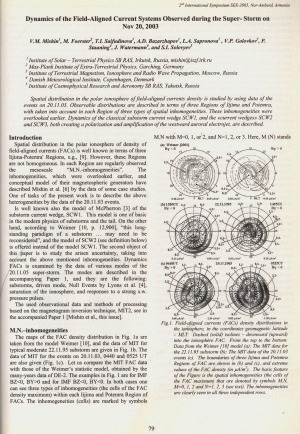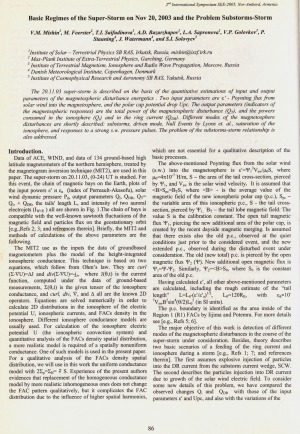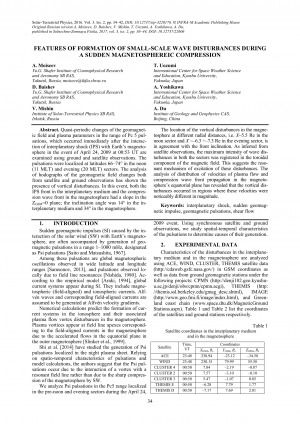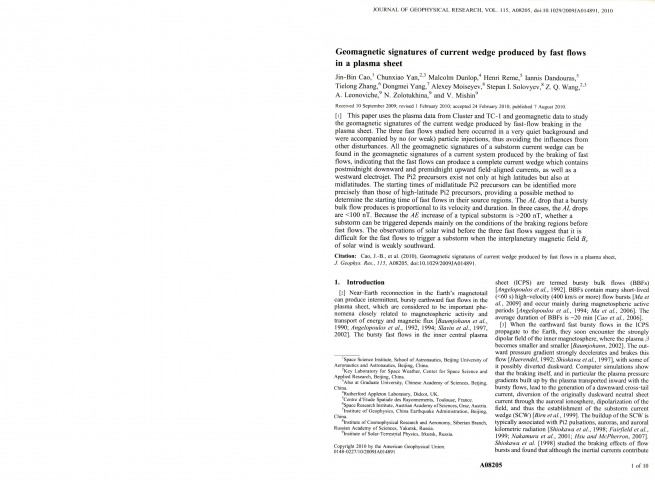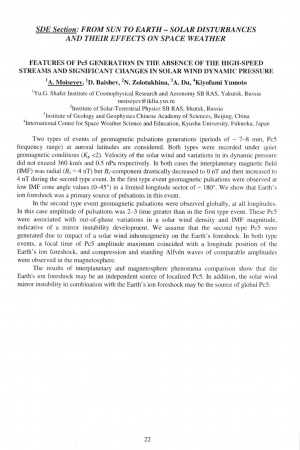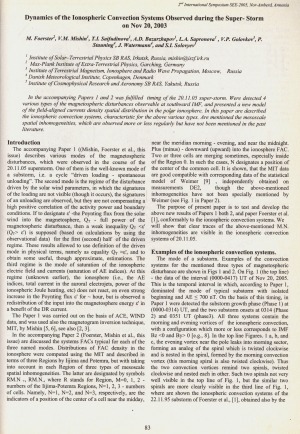Количество страниц: 4 с.
Dynamics of the Field-Aligned Current Systems Observed during The Super-Storm on Nov. 20, 2003 / V. M. Mishin, M. Foerster, T. I. Saifudinova, A. D. Bazarzhapov, L. A. Sapronova, V. P. Golovkov, P. Stauning, J. Watermann, and S. I. Solovyev // Solar Extreme Events Fundamental Science and Applied Aspects Nor-Amberd, Armenia 26-30 September 2005 : proceedings of the Second International Symposium / edited by A. Chilingarian and G. Karapetyan. − Erevan : Cosmic Ray Division, Alikhanyan Physics Institute, 2006. − P. 79-82.
Количество страниц: 4 с.
- Математика. Естественные науки > Астрономия. Астрофизика. Исследование космического пространства. Геодезия,
- Математика. Естественные науки > Геология. Геологические и геофизические науки,
- НАУКА ЯКУТИИ > МАТЕМАТИКА. ЕСТЕСТВЕННЫЕ НАУКИ > Астрономия. Астрофизика. Исследование космического пространства. Геодезия,
- НАУКА ЯКУТИИ > МАТЕМАТИКА. ЕСТЕСТВЕННЫЕ НАУКИ > Геология. Геологические и геофизические науки.
Basic Regimes of the Super-Storm on Nov 20, 2003 and the Problems Substorms-Storm / V. M. Mishin, M. Foerster, T. I. Saifudinova, A. D. Bazarzhapov, L. A. Sapronova, V. P. Golovkov, P. Stauning, J. Watermann, and S. I. Solovyev // Solar Extreme Events Fundamental Science and Applied Aspects Nor-Amberd, Armenia 26-30 September 2005 : proceedings of the Second International Symposium / edited by A. Chilingarian and G. Karapetyan. − Erevan : Cosmic Ray Division, Alikhanyan Physics Institute, 2006. − P. 86-89.
Количество страниц: 9 с.
- Математика. Естественные науки > Астрономия. Астрофизика. Исследование космического пространства. Геодезия,
- Математика. Естественные науки > Геология. Геологические и геофизические науки,
- НАУКА ЯКУТИИ > МАТЕМАТИКА. ЕСТЕСТВЕННЫЕ НАУКИ > Астрономия. Астрофизика. Исследование космического пространства. Геодезия,
- НАУКА ЯКУТИИ > МАТЕМАТИКА. ЕСТЕСТВЕННЫЕ НАУКИ > Геология. Геологические и геофизические науки.
Quasi-periodic changes of the geomagnetic field and plasma parameters in the range of Pc 5 pulsations, which occurred immediately after the interaction of interplanetary shock (IPS) with Earth’s magnetosphere in the event of April 24, 2009 at 00:53 UT are examined using ground and satellite observations. The pulsations were localized at latitudes 66-74° in the noon (11 MLT) and evening (20 MLT) sectors. The analysis of hodographs of the geomagnetic field changes both from satellite and ground observations has shown the presence of vortical disturbances. In this event, both the IPS front in the interplanetary medium and the compression wave front in the magnetosphere had a slope in the ZGSM=0 plane; the inclination angle was 14° in the interplanetary medium and 34° in the magnetosphere. The location of the vortical disturbances in the magnetosphere at different radial distances, i.e. X ~5.5 Re in the noon sector and X ~-6.3 ÷-7.3 Re in the evening sector, is in agreement with the front inclination. As inferred from satellite observations, the maximum intensity of wave disturbances in both the sectors was registered in the toroidal component of the magnetic field. This suggests the resonant mechanism of excitation of these disturbances. The analysis of distribution of velocities of plasma flow and compression wave front propagation in the magnetosphere’s equatorial plane has revealed that the vortical disturbances occurred in regions where these velocities were noticeably different in magnitude.
Features of formation of small-scale wave disturbances during a sudden magnetosphereic compression = Особенности формирования мелкомасштабных волновых возмущений во время резкого сжатия магнитосферы / A. Moiseev, D. Baihsev, V. Mishin, T. Uozumi, A. Yoshikawa, A. Du // Солнечно-земная физика = Solar-Terrestrial Physics. – 2017, т. 3, N 2 : 13-я российско-китайская конференция по космической погоде. – С. 36-44.
DOI: 10.12737/22606
Количество страниц: 6 с.
Geomagnetic signatures of current wedge produced by fast flows in a plasma sheet / Jin-Bin Cao, Chunxiao Yan, Malcolm Dunlop, Henri Reme, Iannis Dandouras, Tielong Zhang, Dongmei Yang, Alexey Moiseyev, Stepan I. Solovyev, Z. Q. Wang, A. Leonoviche, N. Zolotukhina, and V. Mishin // Journal of Geophysical Research: Space Physics. – 1978. – 2010 (August), vol. 115, N 8. – P. A08205.
Количество страниц: 2 с.
Features of Pc5 generation in the absence of the high-speed streams and significant changes in solar wind dynamic pressure : [тезисы докладов] / A. Moiseyev, D. Baishev, N. Zolotukhina, A. Du, K. Yumoto // Physics of auroral phenomena : 26th annual seminar, 25-28 February 2003 : abstacts. – 2003. – P. 22.
Количество страниц: 3 с.
- Математика. Естественные науки > Астрономия. Астрофизика. Исследование космического пространства. Геодезия,
- Математика. Естественные науки > Геология. Геологические и геофизические науки,
- Прикладные науки. Медицина. Ветеринария. Техника. Сельское хозяйство > Инженерное дело. Техника в целом,
- НАУКА ЯКУТИИ > МАТЕМАТИКА. ЕСТЕСТВЕННЫЕ НАУКИ > Астрономия. Астрофизика. Исследование космического пространства. Геодезия,
- НАУКА ЯКУТИИ > ПРИКЛАДНЫЕ НАУКИ. МЕДИЦИНА. ТЕХНИКА. СЕЛЬСКОЕ ХОЗЯЙСТВО > Инженерное дело. Техника в целом,
- НАУКА ЯКУТИИ > МАТЕМАТИКА. ЕСТЕСТВЕННЫЕ НАУКИ > Геология. Геологические и геофизические науки.
Dynamics of the Ionospheric Convection Systems Observed during The Super-Storm on Nov. 20, 2003 / M. Foerster, V. M. Mishin, T. I. Saifudinova, A. D. Bazarzhapov, L. A. Sapronova, V. P. Golovkov, P. Stauning, J. Watermann, and S. I. Solovyev // Solar Extreme Events Fundamental Science and Applied Aspects Nor-Amberd, Armenia 26-30 September 2005 : proceedings of the Second International Symposium / edited by A. Chilingarian and G. Karapetyan. − Erevan : Cosmic Ray Division, Alikhanyan Physics Institute, 2006. − P. 83-85.
